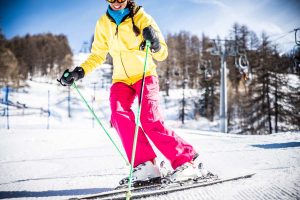Ski boots are one of the most important pieces of equipment when it comes to skiing and snowboarding. Not only do they provide traction and support, but they also protect your feet and ankles from snow and cold temperatures. As such, it’s important to choose the right ski boots for your skill level and needs. In this article, we’ll discuss how to fit ski boots, the different types of ski boots available, factors to consider when choosing ski boots, and how to care for them. With the right information, you’ll be able to make an informed decision about which ski boots are best for you.
Fitting Ski Boots
When it comes to fitting ski boots, there are several important factors to consider. It’s important to get the right size, as too small or too large a fit can cause discomfort and prevent you from enjoying your time on the slopes. Additionally, it’s important to check for any pressure points or areas of discomfort. Finally, you should make sure that your toes do not touch the front of the boot when you’re standing, as this can lead to discomfort and even injury. With the right fit, you’ll be able to ski or snowboard with ease and comfort.
What to look for when trying on ski boots
When trying on ski boots, it’s important to make sure you have enough room in the toe box, that there is no pressure on any part of your foot, that your heel does not lift when you stand, and that your toes do not touch the front of the boot. Additionally, you should make sure that the boot is comfortable and that it fits securely around the ankle. It’s also important to make sure that the boot is tight enough to provide support, but not too tight that it causes discomfort. Finally, you should make sure that the boot is properly laced up and that you are able to easily adjust the laces.
Some signs that the boots are not a good fit include discomfort, heel lift, pressure points, and toes touching the front of the boot. Additionally, if the boot is too loose or too tight, it is not a good fit. If you experience any of these issues while trying on ski boots, it’s important to try on a different pair until you find a fit that works for you.
The importance of getting the right fit
Getting the right fit for your ski boots is incredibly important. Not only will a properly fitting boot provide more comfort and support, but it can also help to prevent injuries. If your boots are too loose, you may find yourself slipping and sliding, which can lead to falls and injuries. If your boots are too tight, you may experience discomfort, pain, and even numbness. Additionally, a proper fit can help to improve your balance and control on the slopes. With the right fit, you’ll be able to enjoy your time on the slopes without any issues.
Some signs that you have a good fit on your ski boots include:
- No discomfort
- No heel lift
- No pressure points
- No toes touching the front of the boot.
Additionally, the boot should be tight enough to provide support but not too tight to cause discomfort. The boot should also fit securely around the ankle and be easily adjustable. Finally, you should be able to stand in the boot without any issues.
Different Types of Ski Boots
When it comes to choosing ski boots, there are several different types available. The type of boot you choose will depend on your skill level, preferences, and needs. Recreational ski boots are designed for casual skiers and are great for beginners. Performance ski boots are designed for intermediate skiers and provide more support and control. Race ski boots are designed for advanced skiers and offer the most control and power. With the right information, you’ll be able to make an informed decision about which type of ski boots are best for you.
Recreational Ski Boots
Recreational ski boots are designed for casual skiers and are great for those who are just starting out. These boots are typically more comfortable and offer more flexibility. They usually have a softer flex rating and are easier to get in and out of. Additionally, they are usually lighter in weight, making them easier to maneuver. Recreational ski boots are a great choice for those who are just beginning to ski or who want a more comfortable fit.
Some of the most important features of a good recreational ski boot include a softer flex rating, a lighter weight, and a comfortable fit. Additionally, recreational ski boots should be easy to get in and out of and have a lower cuff for more comfortable fit. Finally, they should offer some adjustability to allow you to customize the fit to your needs.
Performance Ski Boots
Performance ski boots are designed for intermediate skiers who need more support and control. These boots are stiffer and have a higher flex rating, which provides more power and stability when skiing. They are also more adjustable, allowing you to customize the fit to your needs. Additionally, they usually have a higher cuff and better ankle support, which can help to improve balance and control. Performance ski boots are a great choice for those who are looking for more power and control on the slopes.
Some of the most important features of a good performance ski boot include a stiffer flex rating, a higher cuff for better ankle support, and adjustable features to allow you to customize the fit to your needs. Additionally, performance ski boots should have a higher weight for more stability and control and should be comfortable to wear.
Race Ski Boots
Race ski boots are designed for advanced skiers and offer the most control and power. These boots are typically the stiffest and have the highest flex rating. They also have a higher cuff and more ankle support, which can help to improve balance and control when skiing. Additionally, many race ski boots have adjustable features to allow you to customize the fit to your needs. Race ski boots are a great choice for those who are looking for the most power and control on the slopes.
Some of the most important features of a good race ski boot include a higher flex rating, a higher cuff for better ankle support, and adjustable features to allow you to customize the fit to your needs. Additionally, race ski boots should have a higher weight for more stability and control and should be comfortable to wear. Finally, race ski boots should have a secure closure system to ensure a secure fit.
Factors to Consider when Choosing Ski Boots
When it comes to choosing ski boots, there are several factors to consider. It’s important to think about your skill level, preferences, and needs to make sure you get the right boots for you. Additionally, you should consider factors such as flexibility, weight, and boot sole compatibility to ensure you get the most out of your ski boots. With the right information, you’ll be able to make an informed decision about which ski boots are best for you.
Flexibility
Flexibility is an important factor to consider when choosing ski boots. Generally, the more flexible a boot is, the more comfortable it will be. Recreational ski boots are typically the most flexible and are great for those who are just beginning. Performance ski boots are usually medium-flex boots and are ideal for intermediate skiers. Race ski boots are usually the stiffest and offer the most control and power. Depending on your skill level and needs, you should choose the right flex rating for you.
Weight
Weight is another important factor to consider when choosing ski boots. Generally, the lighter the boot is, the easier it will be to maneuver. Recreational ski boots are typically the lightest, which makes them easier to maneuver for beginners. Performance ski boots are usually medium-weight and provide more stability and control. Race ski boots are usually the heaviest and offer the most power and control. Depending on your skill level and needs, you should choose the right weight for you.
Boot Sole Compatibility
Boot sole compatibility is also an important factor to consider when choosing ski boots. Different boots have different sole compatibility, so it’s important to make sure your boots are compatible with your bindings. Generally, recreational ski boots are the most compatible and can be used with most bindings. Performance and race ski boots are usually less compatible and may require specific bindings. Depending on your needs, you should make sure you get the right sole compatibility for you.
How to Care for Ski Boots
Once you’ve chosen the right ski boots for you, it’s important to make sure you take proper care of them. Ski boots can last for years with the right maintenance and care. In this section, we’ll discuss how to clean and dry your boots, how to store and transport them, and other tips for keeping your boots in good condition. With the right care, your ski boots will last for many years.
Cleaning and Drying
Cleaning and drying your ski boots is an important part of keeping them in good condition. After each use, you should remove any dirt or debris from the outside of the boot and the liner. If there is any moisture in the boot, you should dry it out before storing. Additionally, you should check for any signs of wear or damage and replace any parts as needed. Regular cleaning and drying can help to keep your boots in good condition and make them last longer.
The steps for cleaning and drying your ski boots include:
- Remove any dirt or debris from the outside of the boot and the liner.
- If there is any moisture in the boot, dry it out before storing.
- Check for any signs of wear or damage and replace any parts as needed.
- Store your boots in a cool, dry place away from direct sunlight.
- Use a boot bag to protect the boots when transporting them.
- Make sure your boots are properly secured in the car or on the ski lift.
Storing and Transporting
Storing and transporting your ski boots is also an important part of keeping them in good condition. When not in use, you should store your boots in a cool, dry place away from direct sunlight. Additionally, you should use a boot bag to protect the boots when transporting them. Finally, you should make sure your boots are properly secured in the car or on the ski lift. The right storage and transportation practices can help to keep your ski boots in good condition and make them last longer.
Choosing the right ski boots is an important part of enjoying your time on the slopes. It’s important to get the right fit, choose the right type of boot for your skill level and needs, and consider factors such as flexibility, weight, and sole compatibility. Additionally, it’s important to take proper care of your ski boots by cleaning and drying them regularly, storing them in a cool, dry place, and transporting them properly. With the right information and care, you’ll be able to make an informed decision about which ski boots are best for you.
More Skiing Posts
Tylor Bennett
An editor at Outdoors ReportTylor Bennett is a senior editor for the blogzine and also reports on breaking news based in London. He has written about government, criminal justice, and the role of money in politics since 2015.












